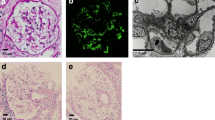Abstract
C1q nephropathy (C1qN) is an uncommon disorder seen in children and adults with nephrotic syndrome and non-specific urinary findings. It has been described with minimal change nephrotic syndrome (MCNS), focal segmental glomerulonephritis and isolated mesangial proliferative glomerulonephritis. We describe nine children with MCNS and mesangial C1q deposition. These children had a median age of 2.7 years at diagnosis (range 1.3–15 years), 56% were male and 78% were Hispanic. We compared these children to concurrent patients with nephrotic syndrome and biopsy-proven MCNS. We found that the C1qN patients were more likely than MCNS children to require chronic immunosuppression with calcineurin inhibitors or mycophenolate mofetil to maintain remission. However, all children were able to achieve and sustain clinical remission of nephrotic syndrome. Children with C1qN and minimal change histology have an increased frequency of frequently relapsing and steroid-unresponsive disease, but they can attain prolonged remission and stable renal function with calcineurin inhibitor or mycophenolate mofetil therapy.

Similar content being viewed by others
References
Jennette JC, Hipp CG (1985) C1q nephropathy: a distinct pathologic entity usually causing nephrotic syndrome. Am J Kidney Dis 6:103–110
Kersnik Levart T, Kenda RB, Avgustin Cavic M, Ferluga D, Hvala A, Vizjak A (2005) C1Q nephropathy in children. Pediatr Nephrol 20:1756–1761
Lau KK, Gaber LW, Delos Santos NM, Wyatt RJ (2005) C1q nephropathy: features at presentation and outcome. Pediatr Nephrol 20:744–749
Iskandar SS, Browning MC, Lorentz WB (1991) C1q nephropathy: a pediatric clinicopathologic study. Am J Kidney Dis 18:459–465
Markowitz GS, Schwimmer JA, Stokes MB, Nasr S, Seigle RL, Valeri AM, D’Agati VD (2003) C1q nephropathy: a variant of focal segmental glomerulosclerosis. Kidney Int 64:1232–1240
Fukuma Y, Hisano S, Segawa Y, Niimi K, Tsuru N, Kaku Y, Hatae K, Kiyoshi Y, Mitsudome A, Iwasaki H (2006) Clinicopathologic correlation of C1q nephropathy in children. Am J Kidney Dis 47:412–418
International Study of Kidney Disease in Children (1978) Nephrotic syndrome in children: prediction of histopathology from clinical and laboratory characteristics at time of diagnosis. A report of the International Study of Kidney Disease in Children. Kidney Int 13:159–165
International Study of Kidney Disease in Children (1981) The primary nephrotic syndrome in children. Identification of patients with minimal change nephrotic syndrome from initial response to prednisone. A report of the International Study of Kidney Disease in Children. J Pediatr 98:561–564
Task Force on Blood Pressure Control in Children (1987) Report of the second task force on blood pressure control in children-1987. Task force on blood pressure control in children. national heart, lung, and blood institute, Bethesda, Maryland. Pediatrics 79:1–25
Arbeitsgemeinschaft für Pädiatrische Nephrologie (1988) Short versus standard prednisone therapy for initial treatment of idiopathic nephrotic syndrome in children. Arbeitsgemeinschaft fur Pädiatrische Nephrologie. Lancet 1:380–383
Hiraoka M, Tsukahara H, Matsubara K, Tsurusawa M, Takeda N, Haruki S, Hayashi S, Ohta K, Momoi T, Ohshima Y, Suganuma N, Mayumi M (2003) A randomized study of two long-course prednisolone regimens for nephrotic syndrome in children. Am J Kidney Dis 41:1155–1162
Brodehl J, Krohn HP, Ehrich JH (1982) The treatment of minimal change nephrotic syndrome (lipoid nephrosis): cooperative studies of the Arbeitsgemeinschaft für Pädiatrische Nephrologie (APN). Klin Padiatr 194:162–165
Ueda N, Kuno K, Ito S (1990) Eight and 12 week courses of cyclophosphamide in nephrotic syndrome. Arch Dis Child 65:1147–1150
Srivastava T, Chadha V, Taboada EM, Alon US (2000) C1q nephropathy presenting as rapidly progressive crescentic glomerulonephritis. Pediatr Nephrol 14:976–979
Kari JA, Jalalah SM (2008) C1q nephropathy in two young sisters. Pediatr Nephrol 23:487–490
Southwest Pediatric Nephrology Study Group (1983) Childhood nephrotic syndrome associated with diffuse mesangial hypercellularity. A report of the Southwest Pediatric Nephrology Study Group. Kidney Int 24:87–94
Border WA (1988) Distinguishing minimal-change disease from mesangial disorders. Kidney Int 34:419–434
Bandin F, Merhenberger M, Modesto A, Brochard K, Decramer S (2008) Steroid-responsive nephrotic syndrome in a child with juvenile idiopathic arthritis. Pediatr Nephrol 23:651–654
Gulati S, Sharma AP, Sharma RK, Gupta A, Gupta RK (2002) Do current recommendations for kidney biopsy in nephrotic syndrome need modifications? Pediatr Nephrol 17:404–408
Ahmad H, Tejani A (2000) Predictive value of repeat renal biopsies in children with nephrotic syndrome. Nephron 84:342–346
Southwest Pediatric Nephrology Study Group (1985) Focal segmental glomerulosclerosis in children with idiopathic nephrotic syndrome. A report of the Southwest Pediatric Nephrology Study Group. Kidney Int 27:442–449
Schwartz GJ, Brion LP, Spitzer A (1987) The use of plasma creatinine concentration for estimating glomerular filtration rate in infants, children, and adolescents. Pediatr Clin North Am 34:571–590
Author information
Authors and Affiliations
Corresponding author
Rights and permissions
About this article
Cite this article
Wong, C.S., Fink, C.A., Baechle, J. et al. C1q nephropathy and minimal change nephrotic syndrome. Pediatr Nephrol 24, 761–767 (2009). https://doi.org/10.1007/s00467-008-1058-9
Received:
Revised:
Accepted:
Published:
Issue Date:
DOI: https://doi.org/10.1007/s00467-008-1058-9




